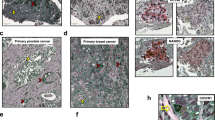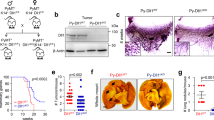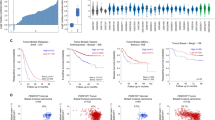Abstract
Cancer metastasis is a lethal problem that claims the lives of over 90% of cancer patients. In this study, we have investigated metastatic potential of cancer stem cells (CSCs) isolated from mammary tumors of a Brca1-mutant mouse model. Our data indicated that CSCs, which are enriched in CD24+CD29+/CD49f+ cell population, displayed much higher migration ability than CD24−CD29−/CD49f− cells in tissue culture and enhanced metastatic potential in allograft-nude mice. CD24+CD29+ cells maintained the ability to differentiate and reconstitute heterogeneity in the metastatic tumors whereas CD24−CD29− cells could not. Corresponding to their enhanced metastatic ability, CD24+CD29+ cells exhibited features of the epithelial to mesenchymal transition. Finally, using short hairpin RNA to knock down CD29 and/or CD49f in metastatic cancer cells, we demonstrated that while acute knockdown of CD29 or CD49f alone slightly decreased cell migration ability, knockdown of both genes generated a profound effect to block their migration, revealing an overlapping, yet critical function of both genes in the migration of CSCs. Our findings indicate that in addition to serving as markers of CSCs, CD29 and CD49f may also serve as potential therapeutic targets for cancer metastasis.
This is a preview of subscription content, access via your institution
Access options
Subscribe to this journal
Receive 50 print issues and online access
$259.00 per year
only $5.18 per issue
Buy this article
- Purchase on Springer Link
- Instant access to full article PDF
Prices may be subject to local taxes which are calculated during checkout




Similar content being viewed by others
References
Jemal A, Siegel R, Xu J, Ward E . Cancer statistics 2010 CA Cancer J Clin 2010; 60: 277–300.
Hanahan D, Weinberg RA . The hallmarks of cancer. Cell 2000; 100: 57–70.
Bernards R, Weinberg RA . A progression puzzle. Nature 2002; 418: 823.
Wright JA, Egan SE, Greenberg AH . Genetic regulation of metastatic progression. Anticancer Res 1990; 10: 1247–1255.
van de Vijver MJ, He YD, van't Veer LJ, Dai H, Hart AA, Voskuil DW et al. A gene-expression signature as a predictor of survival in breast cancer. N Engl J Med 2002; 347: 1999–2009.
Nicolson GL . Paracrine/autocrine growth mechanisms in tumor metastasis. Oncol Res 1992; 4: 389–399.
Husemann Y, Geigl JB, Schubert F, Musiani P, Meyer M, Burghart E et al. Systemic spread is an early step in breast cancer. Cancer Cell 2008; 13: 58–68.
Podsypanina K, Du YC, Jechlinger M, Beverly LJ, Hambardzumyan D, Varmus H . Seeding and propagation of untransformed mouse mammary cells in the lung. Science 2008; 321: 1841–1844.
Al-Hajj M, Wicha MS, Benito-Hernandez A, Morrison SJ, Clarke MF . Prospective identification of tumorigenic breast cancer cells. Proc Natl Acad Sci U S A 2003; 100: 3983–3988.
Galli R, Binda E, Orfanelli U, Cipelletti B, Gritti A, De Vitis S et al. Isolation and characterization of tumorigenic, stem-like neural precursors from human glioblastoma. Cancer Res 2004; 64: 7011–7021.
Li C, Heidt DG, Dalerba P, Burant CF, Zhang L, Adsay V et al. Identification of pancreatic cancer stem cells. Cancer Res 2007; 67: 1030–1037.
O'Brien CA, Pollett A, Gallinger S, Dick JE . A human colon cancer cell capable of initiating tumour growth in immunodeficient mice. Nature 2007; 445: 106–110.
Baccelli I, Trumpp A . The evolving concept of cancer and metastasis stem cells. J Cell Biol 2012; 198: 281–293.
Song LL, Miele L . Cancer stem cells—an old idea that's new again: implications for the diagnosis and treatment of breast cancer. Expert Opin Biol Ther 2007; 7: 431–438.
Mani SA, Guo W, Liao MJ, Eaton EN, Ayyanan A, Zhou AY et al. The epithelial-mesenchymal transition generates cells with properties of stem cells. Cell 2008; 133: 704–715.
Liu R, Wang X, Chen GY, Dalerba P, Gurney A, Hoey T et al. The prognostic role of a gene signature from tumorigenic breast-cancer cells. N Engl J Med 2007; 356: 217–226.
Liu H, Patel MR, Prescher JA, Patsialou A, Qian D, Lin J et al. Cancer stem cells from human breast tumors are involved in spontaneous metastases in orthotopic mouse models. Proc Natl Acad Sci U S A 2010; 107: 18115–18120.
Dave B, Mittal V, Tan NM, Chang JC . Epithelial-mesenchymal transition, cancer stem cells and treatment resistance. Breast Cancer Res 2012; 14: 202.
Foroni C, Broggini M, Generali D, Damia G . Epithelial-mesenchymal transition and breast cancer: role, molecular mechanisms and clinical impact. Cancer Treat Rev 2012; 38: 689–697.
Hale JS, Li M, Lathia JD . The malignant social network: cell-cell adhesion and communication in cancer stem cells. Cell Adh Migr 2012; 6: 346–355.
Lathia JD, Heddleston JM, Venere M, Rich JN . Deadly teamwork: neural cancer stem cells and the tumor microenvironment. Cell Stem Cell 2011; 8: 482–485.
Miki Y, Swensen J, Shattuck-Eidens D, Futreal PA, Harshman K, Tavtigian S et al. A strong candidate for the breast and ovarian cancer susceptibility gene BRCA1. Science 1994; 266: 66–71.
Alberg AJ, Helzlsouer KJ . Epidemiology, prevention, and early detection of breast cancer. Curr Opin Oncol 1997; 9: 505–511.
Zhang J, Powell SN . The role of the BRCA1 tumor suppressor in DNA double-strand break repair. Mol Cancer Res 2005; 3: 531–539.
Brody LC, Biesecker BB . Breast cancer susceptibility genes. BRCA1 and BRCA2. Medicine (Baltimore) 1998; 77: 208–226.
Eccles DM, Pichert G . Familial non-BRCA1/BRCA2-associated breast cancer. Lancet Oncol 2005; 6: 705–711.
Hu Y . BRCA1, hormone, and tissue-specific tumor suppression. Int J Biol Sci 2009; 5: 20–27.
Deng CX . Tumor formation in Brca1 conditional mutant mice. Environ Mol Mutagen 2002; 39: 171–177.
Deng CX . BRCA1: cell cycle checkpoint, genetic instability, DNA damage response, and cancer evolution. Nucleic Acids Res 2006; 34: 1416–1426.
Diaz-Cruz ES, Cabrera MC, Nakles R, Rutstein BH, Furth PA . BRCA1 deficient mouse models to study pathogenesis and therapy of triple negative breast cancer. Breast Dis 2010; 32: 85–97.
Roy R, Chun J, Powell SN . BRCA1 and BRCA2: different roles in a common pathway of genome protection. Nat Rev Cancer 2012; 12: 68–78.
Venkitaraman AR . Cancer susceptibility and the functions of BRCA1 and BRCA2. Cell 2002; 108: 171–182.
Drost RM, Jonkers J . Preclinical mouse models for BRCA1-associated breast cancer. Br J Cancer 2009; 101: 1651–1657.
Deng CX, Wang RH . Roles of BRCA1 in DNA damage repair: a link between development and cancer. Hum Mol Genet 2003; 12: R113–R123.
Deng CX, Brodie SG . Roles of BRCA1 and its interacting proteins. Bioessays 2000; 22: 728–737.
Dine J, Deng CX . Mouse models of BRCA1 and their application to breast cancer research. Cancer Metast Rev 2012; 32: 25–37.
Shackleton M, Vaillant F, Simpson KJ, Stingl J, Smyth GK, Asselin-Labat ML et al. Generation of a functional mammary gland from a single stem cell. Nature 2006; 439: 84–88.
Stingl J, Eirew P, Ricketson I, Shackleton M, Vaillant F, Choi D et al. Purification and unique properties of mammary epithelial stem cells. Nature 2006; 439: 993–997.
Vassilopoulos A, Wang RH, Petrovas C, Ambrozak D, Koup R, Deng CX . Identification and characterization of cancer initiating cells from BRCA1 related mammary tumors using markers for normal mammary stem cells. Int J Biol Sci 2008; 4: 133–142.
van 't Veer LJ, Dai H, van de Vijver MJ, He YD, Hart AA, Mao M et al. Gene expression profiling predicts clinical outcome of breast cancer. Nature 2002; 415: 530–536.
Gritsenko PG, Ilina O, Friedl P . Interstitial guidance of cancer invasion. J Pathol 2012; 226: 185–199.
Lanza DG, Ma J, Guest I, Uk-Lim C, Glinskii A, Glinsky G et al. Tumor-derived mesenchymal stem cells and orthotopic site increase the tumor initiation potential of putative mouse mammary cancer stem cells derived from MMTV-PyMT mice. Tumour Biol 2012; 33: 1997–2005.
Zhang M, Behbod F, Atkinson RL, Landis MD, Kittrell F, Edwards D et al. Identification of tumor-initiating cells in a p53-null mouse model of breast cancer. Cancer Res 2008; 68: 4674–4682.
Lahlou H, Muller WJ . Beta1-integrins signaling and mammary tumor progression in transgenic mouse models: implications for human breast cancer. Breast Cancer Res 2011; 13: 229.
Ali HR, Dawson SJ, Blows FM, Provenzano E, Pharoah PD, Caldas C . Cancer stem cell markers in breast cancer: pathological, clinical and prognostic significance. Breast Cancer Res 2011; 13: R118.
Lee EC, Lotz MM, Steele GD Jr, Mercurio AM . The integrin alpha 6 beta 4 is a laminin receptor. J Cell Biol 1992; 117: 671–678.
Nielsen PK, Yamada Y . Identification of cell-binding sites on the Laminin alpha 5 N-terminal domain by site-directed mutagenesis. J Biol Chem 2001; 276: 10906–10912.
Niessen CM, Cremona O, Daams H, Ferraresi S, Sonnenberg A, Marchisio PC . Expression of the integrin alpha 6 beta 4 in peripheral nerves: localization in Schwann and perineural cells and different variants of the beta 4 subunit. J Cell Sci 1994; 107 (Pt 2): 543–552.
Sonnenberg A, Gehlsen KR, Aumailley M, Timpl R . Isolation of alpha 6 beta 1 integrins from platelets and adherent cells by affinity chromatography on mouse laminin fragment E8 and human laminin pepsin fragment. Exp Cell Res 1991; 197: 234–244.
Acknowledgements
We thank members of the Deng lab for critical reading of the manuscript. This work was supported by the Intramural Research Program of the National Institute of Diabetes, Digestive and Kidney Diseases, National Institutes of Health, USA.
Author information
Authors and Affiliations
Corresponding author
Ethics declarations
Competing interests
The authors declare no conflict of interest.
Additional information
Supplementary Information accompanies this paper on the Oncogene website
Supplementary information
Rights and permissions
About this article
Cite this article
Vassilopoulos, A., Chisholm, C., Lahusen, T. et al. A critical role of CD29 and CD49f in mediating metastasis for cancer-initiating cells isolated from a Brca1-associated mouse model of breast cancer. Oncogene 33, 5477–5482 (2014). https://doi.org/10.1038/onc.2013.516
Received:
Revised:
Accepted:
Published:
Issue Date:
DOI: https://doi.org/10.1038/onc.2013.516
Keywords
This article is cited by
-
SIX1 amplification modulates stemness and tumorigenesis in breast cancer
Journal of Translational Medicine (2023)
-
Extirpating the cancer stem cell hydra: Differentiation therapy and Hyperthermia therapy for targeting the cancer stem cell hierarchy
Clinical and Experimental Medicine (2023)
-
Establishment of a bladder cancer cell line expressing both mesenchymal and epithelial lineage-associated markers
Human Cell (2021)
-
Chronic circadian disruption modulates breast cancer stemness and immune microenvironment to drive metastasis in mice
Nature Communications (2020)
-
Inhibiting WNT and NOTCH in renal cancer stem cells and the implications for human patients
Nature Communications (2020)



